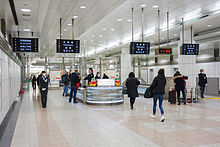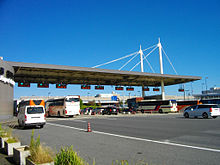Narita International Airport
This is the sighted version that was marked on June 11, 2021. There are 2 pending changes that still need to be sighted.
i1 i3
i7 i10 i12 i14
Tokyo Narita Airport (Jap. 成田国際空港 Narita Kokusai Kūkō, Engl. "Narita International Airport"; officially Narita International Airport, formerly New Tokyo International Airport; IATA airport code: NRT, ICAO airport code: RJAA) is one of Tokyo's international airports and is considered a 1st class airport by Japanese law. In Japan, it is usually referred to as Narita Airport (jap. 成田空港 Narita Kūkō), as the airport is located in the city of Narita in Chiba Prefecture, about 60 kilometres northeast of Tokyo. With around 36 million passengers in 2014, it is the second busiest airport in Japan and ranks 45th in the world. It is also considered the tenth busiest cargo airport in the world, handling around two million tonnes of cargo in 2013.
The airport serves as a hub for All Nippon Airways, Japan Airlines, Nippon Cargo Airlines, Air Japan, Delta Air Lines, United Airlines, Peach Aviation, Jetstar Japan, Vanilla Air and Spring Airlines Japan.
History
In the 1950s and 1960s, Japan's economy grew strongly, and passenger numbers at Tokyo's Haneda Airport, which opened in 1931, increased accordingly. In 1962, it was decided to create a new airport for the capital, the New Tokyo International Airport, which was to take over Haneda's international traffic, while domestic traffic was to remain at the old airport, which was relatively close to the city centre.
Construction began in 1971, but met with fierce opposition from the local population due to land expropriation, which is unusual in Japan. Around 1966, local residents, farmers, students and left-wing parties formed the famous "Sanrizuka-Shibayama Rengo Kūkō Hantai Dōmei" (三里塚・芝山連合空港反対同盟), which lasted until 1983. It repeatedly protested against the construction of the airport and, for example, set up roadblocks in 1967 so that the Ministry of Transportation was prevented from surveying the airport. The Zengakuren organization also sent students to support the farmers in their protests. The first terminal was completed in 1972, but the completion of the runway was delayed for several years as several farmers refused to vacate their land. The opening date was finally set for March 30, 1978, but had to be postponed because a group of activists stormed the tower on March 26 and destroyed key parts of the facility. As a result, the airport did not open until May 20, 1978, with only one runway. The airport was fenced off that day and guarded by 14,000 police. 6000 opponents attacked the police with stones and firebombs, whereupon the police defended themselves with water cannons. At the other end of Tokyo, activists cut the power supply to a district control station in Tokorozawa. This severely disrupted air traffic in the Kantō region for several hours.
It was not until 2002 (after the decision had already been made in 1986) that the second runway was put into operation. However, this could only be partially opened, because this time land expropriations were waived and a local poultry farmer refused to leave his farm located on the area. Initially, the new track was only 2100 meters long. In September 2008, construction work began to extend it to 2500 meters and to expand the taxiways and parking areas, which has been completed since October 2009. Plans for a third runway with a length of 3200 meters have been put on hold until further notice.
Narita is considered one of the most expensive airports in the world as a result of the protests during construction, which can still be felt in the demonstrations still taking place to the present day. Until 2015, there were also security checks when entering the airport grounds to prevent possible attacks by opponents. At one time, landing fees for a Boeing 747 were 948,000 yen (about 7600 euros), but were reduced to 730,750 yen (5800 euros) on October 1, 2005. By comparison, landing fees for this aircraft cost 825,600 yen (6600 euros) at Kansai Airport, but only the equivalent of 322,000 (2600 euros) at Incheon Airport (South Korea) and only 374,000 yen (3000 euros) in Hong Kong. As a result, these airports have been able to expand their position as East Asian hubs very strongly in recent years, while Narita's passenger numbers have been virtually stagnant since 2004.
The airport operator "New Tokyo International Airport Authority" (jap. 新東京国際空港公団 Shin Tōkyō Kokusai Kūkō Kōdan) was transformed into the public joint stock company Narita International Airport Corporation (jap. 成田国際空港株式会社 Narita Kokusai Kūkō Kabushiki Gaisha) (previously a state-owned special fund), which is wholly owned by the state. At the same time, the airport was renamed from "New Tokyo International Airport" to "Narita International Airport" on this date.
As a result of high costs, long transfer times (1.5 h to Haneda domestic airport and Tokyo city centre) and the high cost of fuel, as well as the economic crisis in 2008, there was a decline in passenger numbers during this period from over 35 million in 2007 to 33.8 million, although the airport still reached its capacity limit. Cargo traffic declined particularly sharply during this period. For this reason, an upgrade of the terminals for the Airbus A380 was carried out and more parking spaces for the aircraft were created. In July 2010, the Narita Sky Access rapid transit line was opened, which has since been used by the Skyliner trains of the Keisei Dentetsu railway company to travel to the city centre.

... and at an entrance to Terminal 2.

One of the security checkpoints that screened every visitor until 2015, shown here entering "Gate 2" ...
Airport Facilities
The airport has three terminals. Terminal 1 was opened in 1978, Terminal 2 in 1992 and Terminal 3 in 2015. Tokyo-Narita was one of the first airports to be structured according to the three aviation alliances Star Alliance, Oneworld Alliance and SkyTeam.
![]()
enlarge and show information about the picture
![]()
View over the runway 16R to the airport building.
Terminal 1
Terminal 1 is divided into the "North Wing", "Central Building" and "South Wing". Two satellites are connected to the North Wing and the Central Building, and one to the South Wing. The North Wing is used by airlines of the SkyTeam alliance and the alliance-less Aircalin. The South Wing serves the Star Alliance as well as the airlines Air Busan, MIAT Mongolian Airlines, Uzbekistan Airways and Etihad Airways.
·
Parking lot and entrances to North- and Southwing
·
Check-in and waiting hall of the North Wing
·
Check-in desk in the South Wing
· 
Viewing platform
Terminal 2
Terminal 2 is divided into a main building and a satellite. Until 2013, these were connected by a people mover, which was replaced by a walkway. The terminal is used by the Oneworld Alliance and non-alliance airlines such as Emirates, Philippine Airlines or Pakistan International Airlines.
· 
Main building
·
Check-in desk in the main building
· 
The apron with the former people mover
· 
Viewing platform
Terminal 3
Terminal 3 is 66,000 square meters and is used exclusively by low-cost airlines. The interior design was modest and the floor is reminiscent of a running track.
·
Check-in area
· 
Front view
·
Apron
· ![]()
Bus stop
Other facilities
The cargo airline Nippon Cargo Airlines has its headquarters at the "NCA Line Maintenance Hangar" (jap. NCAライン整備ハンガー NCA Rain Seibi Hangā). Japan Airlines owns the "Japan Airlines Narita Operation Center" (jap. 日本航空成田オペレーションセンター Nihon Kōkū Narita Operēshon Sentā) at the airport, where its former subsidiary JALways was also headquartered. Furthermore, the airport currently houses the world's only fully automated aircraft wash facility.
The Museum of Aeronautical Sciences (jap. 航空科学博物館 Kōkū Kagaku Hakubutsukan) is located in the southern part of the airport and exhibits, among other things, the prototype of the NAMC YS-11.
Search within the encyclopedia


.JPG)


